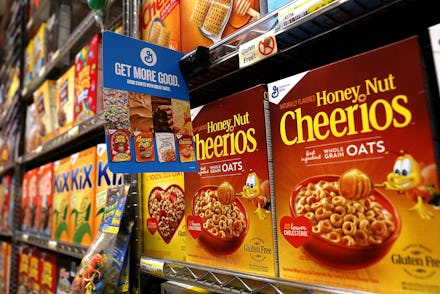A new report finds traces of Monsanto-linked pesticide in kids’ breakfast foods

In August, the Environmental Working Group published a report revealing that traces of glyphosate, an herbicide that has been linked to cancer, was present in many popular oat-based breakfast foods, from brands including Cheerio’s, Lucky Charms and Nutrigrain.
A follow-up report from EWG published Wednesday examines the amount of glyphosate detected in oat-based food that are specifically marketed to children, finding amounts of the pesticide that the EWG deems as unsafe in 26 out of 28 samples tested.
In other words, lots of kids’ food contains the pesticide. Glyphosate is one of the most widely used pesticides in the world and is defined as a “probable carcinogen” by the International Agency for Cancer Research, which is part of the World Health Organization. It’s the active ingredient in many herbicides, including Monsanto’s controversial weed-killer, Roundup, which is at the center of a lawsuit. (Additionally, Bayer recently acquired Monsanto.)
As previously reported, a spokesperson for the Environmental Protection Agency said the agency believes glyphosate “is not likely to be carcinogenic to humans.”
There’s murkiness around what is considered safe in terms of glyphosate levels. The EWG has a health benchmark of 160 parts per billion, considering anything below this number to be safe. The EPA, however, has a current legal limit for glyphosate in oats and many other grains that is much lower, at 30 parts per million.
Why the discrepancy? “EWG’s health benchmark is much more protective than the EPA’s level, specifically to protect children’s health,” Tasha Stoiber, senior scientist at EWG, said in an email. “Since children have an increased susceptibility to cancer-causing substances, it’s standard scientific practice to include a 10-fold margin of safety when setting recommended health limits. This practice is also supported by the federal Food Quality Protection Act.” The EPA, which gets the final say on food safety in the U.S., doesn’t employ this practice.
The EPA has faced criticism over its lenient health benchmark; the agency has been accused of helping Monsanto bury cancer research associated with glyphosate. For years, Monsanto has encouraged the EPA to hamper its investigation into glyphosate’s safety.
“There’s a considerable amount of evidence in academic literature [that shows] the safety levels from [the] government [are] really outdated,” Alexis Temkin, EWG’s toxicologist, previously told Mic. The EWG, as well as the Natural Resources Defense Council has urged the EPA to reassess the risks associated with glyphosate.
The new glyphosate findings
Quaker Oatmeal Squares Honey Nut contained the most egregious amount of glyphosate, with 2,837 parts per billion found in the sample. That’s close to 18 times more than EWG’s children’s health benchmark. “We proudly stand by the safety and quality of our Quaker products,” a spokesperson for the company, which is owned by Pepsi Co, said in an email statement to Mic. “Any minimal levels of glyphosate that may remain in finished products where oats are an ingredient are significantly below regulatory limits and well within compliance of the safety standards set by the Environmental Protection Agency [...] We believe EWG’s approach is invalid, and we stand behind our statement that the Quaker products tested by EWG are safe.”
These findings, along with those reported in August, are stark but also somewhat meaningless: Until the EPA adjusts its safety benchmark for glyphosate exposure, companies will be protected by what the EPA argues is safe. Quaker’s Oatmeal Squares fall well beneath the EPA’s limit.
EWG is going too far, some say
Many companies and EPA advocates argue the EWG’s safety benchmark is overblown. As Slate reported in August, “[I]n order to cross California’s very conservative threshold, you’d need to eat 7½ cups of the worst kind of oatmeal a day.” California’s proposed benchmark is more than 60 times lower than the EPA’s, while the EWG’s is even lower because, as Stoiber said, the group considers children and their increased susceptibility. Still, according to Slate, “You or your child would more likely get sick from simply eating hundreds of cups of cereal a day before you’d get sick from glyphosate.”
Risks associated with glyphosate
In the EPA’s glyphosate assessment, it’s estimated that one- to two-year-old children are likely to have the highest exposure to the carcinogen. Research from the California Environmental Protection Agency shows that in-utero and early life susceptibility to carcinogens are higher than susceptibility in adulthood. Pesticide exposure has also been linked with risks for brain cancer in children, chronic kidney disease and respiratory illnesses.
Oct. 24, 2018, 3:01 p.m. Eastern: This story has been updated.